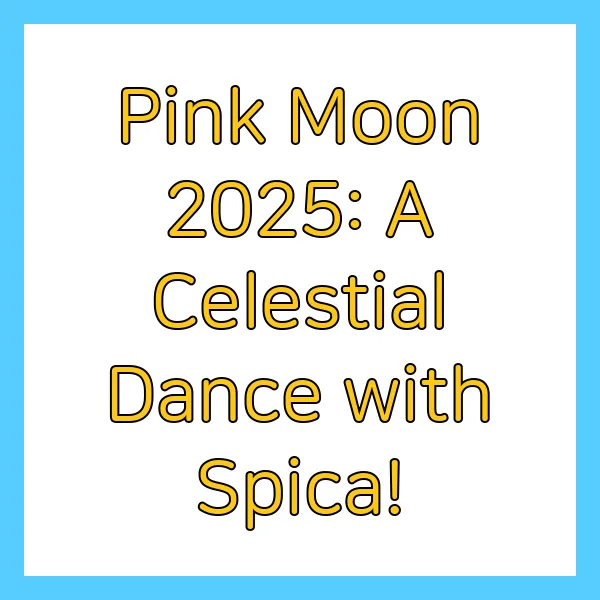
Pink Moon 2025: A Celestial Dance with Spica!

Witness the magic of April's full "Pink Moon" gracing the night sky, and this year, it has a special guest! Get ready for a breathtaking celestial rendezvous as the moon waltzes with Spica, Virgo's brightest star. This guide provides everything you need to witness this astronomical spectacle.
What Makes This Pink Moon Special?
This year, the Pink Moon isn't just about its beautiful rosy hue at moonrise. It's about the close encounter with Spica! How close, you ask? Well, that depends on your location. North American skywatchers will see Spica to the upper left of the moon, while those in South America might witness a lunar occultation of Spica – imagine the moon seemingly swallowing the star! How cool is that?!
Why "Pink" Moon? Think Flowers, not Color!
Don't be fooled by the name. The moon won't actually be pink. The moniker "Pink Moon" is a nod to the vibrant blossoms of Phlox subulata , also known as moss pink, which typically bloom around this time of year in eastern North America. Isn't nature amazing?
Not a Supermoon, But Still a Sight to Behold!
This year's Pink Moon coincides with its apogee – the farthest point in its orbit from Earth. This means it'll be a "micromoon," appearing slightly smaller than usual. But don't let that deter you! Its proximity to Spica will more than compensate, offering a unique celestial tableau.
Planning Your Pink Moon Observation

Want to catch this celestial dance? Here's your game plan. Mark your calendars for April 12th, with peak illumination at 8:22 p.m. EDT. However, the moon will appear full for a few days around this time, offering multiple viewing opportunities.
Best Time to Watch: Embrace the Golden Hour!
While the Pink Moon will be visible throughout the night, the most enchanting view awaits at moonrise. As the moon ascends above the horizon, Earth's atmosphere works its magic, painting the moon in shades of orange and sometimes even a soft pink. This phenomenon is due to the scattering of shorter-wavelength blue light, allowing the longer-wavelength reddish hues to dominate. Pure magic!
Where to Look: East is Your Direction!
Find a spot with an unobstructed view of the eastern horizon. Tall buildings and trees? Nope! Wide-open spaces? Yes! As the sun sets, keep your eyes peeled for the moon's grand entrance. Bonus points if you can find a location away from city lights for minimal light pollution.
Spica: The Virgin's Shining Jewel

Let's get to know Spica, the star of our lunar show! Spica, a blue giant star, is a prominent member of the constellation Virgo. Shining brilliantly at magnitude 1, it's the 15th brightest star in the night sky – a true celestial gem.
Locating Spica: Your Celestial Guide
Spica's position relative to the moon will vary depending on your location. From North America, look for Spica to the upper left of the moon. In South America, prepare for a potential occultation where Spica will appear to pass behind the moon. For those in Europe, Spica will be visible to the lower left of the moon.
A Stellar Duo: Moon and Spica's Dance
The pairing of the full moon and Spica provides a striking visual contrast. The moon, large and luminous, serves as a brilliant backdrop for Spica's sharp, bluish-white sparkle. Don't miss the chance to capture this stunning duo with your camera!
Beyond the Pink Moon: More Celestial Events to Explore

The celestial wonders don't end with the Pink Moon. Keep an eye out for the "Flower Moon" gracing the sky on May 12th. And for the avid stargazer, exploring the constellation Virgo offers a treasure trove of celestial objects. Get ready for a year of astronomical adventures!
Photographing the Pink Moon & Spica: Tips and Tricks

Ready to immortalize this celestial rendezvous? Here are a few tips for capturing stunning photos:
Gear Up: Essential Equipment for Astrophotography
- DSLR or Mirrorless Camera: Allows for manual control over settings.
- Telephoto Lens: Get up close and personal with the moon and Spica.
- Tripod: Essential for stability and sharp images.
- Remote Shutter Release: Prevents camera shake.
Setting the Stage: Camera Settings for Lunar Photography
- ISO: Start low (100-400) and adjust as needed.
- Aperture: f/8 to f/11 for optimal sharpness.
- Shutter Speed: Experiment to find the right balance between exposure and sharpness.
- Focus: Manual focus is your friend here. Focus on the moon or Spica.
Composition is Key: Framing Your Celestial Masterpiece
Consider including elements of the landscape to add depth and interest to your composition. Experiment with different angles and perspectives to create a unique and visually appealing image. Don't be afraid to get creative!
With these tips, you'll be well on your way to capturing breathtaking images of the Pink Moon and Spica. Happy shooting!
'NEWS > SCIENCE' 카테고리의 다른 글
| James Webb Telescope Detects Possible Life Signs on K2-18b (0) | 2025.04.24 |
|---|---|
| STITCHR Gene Editing New RNA Tool for Genetic Diseases (0) | 2025.04.24 |
| CDC Recommends Additional Measles Vaccine Dose for Travelers (0) | 2025.04.22 |
| The Mystical Last Quarter Moon: April 21st, 2025 (0) | 2025.04.21 |
| Parallel Systems Autonomous Battery-Electric Rail Freight (0) | 2025.04.20 |